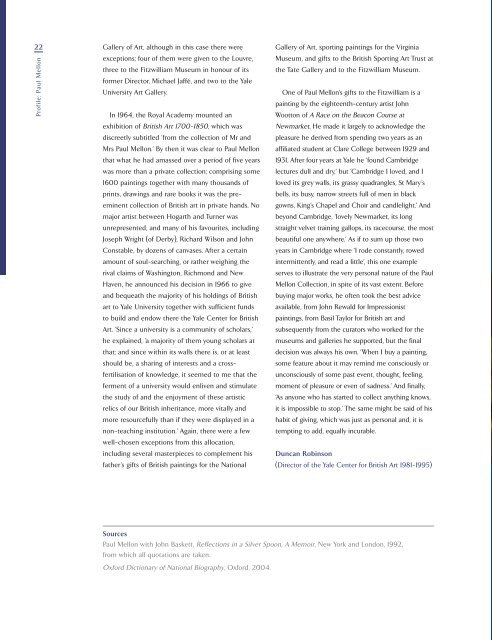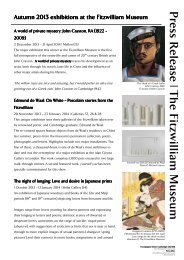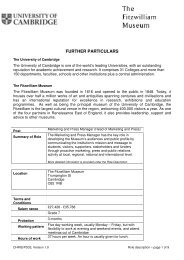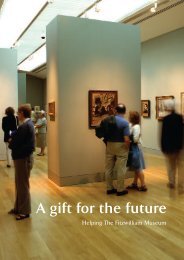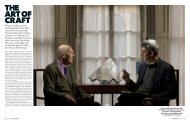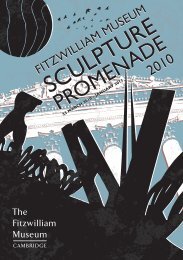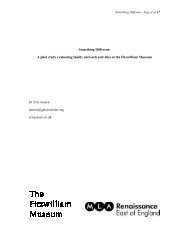The Fitzwilliam Museum - University of Cambridge
The Fitzwilliam Museum - University of Cambridge
The Fitzwilliam Museum - University of Cambridge
You also want an ePaper? Increase the reach of your titles
YUMPU automatically turns print PDFs into web optimized ePapers that Google loves.
22<br />
Pr<strong>of</strong>ile: Paul Mellon<br />
Gallery <strong>of</strong> Art, although in this case there were<br />
exceptions; four <strong>of</strong> them were given to the Louvre,<br />
three to the <strong>Fitzwilliam</strong> <strong>Museum</strong> in honour <strong>of</strong> its<br />
former Director, Michael Jaffé, and two to the Yale<br />
<strong>University</strong> Art Gallery.<br />
In 1964, the Royal Academy mounted an<br />
exhibition <strong>of</strong> British Art 1700-1850, which was<br />
discreetly subtitled ‘from the collection <strong>of</strong> Mr and<br />
Mrs Paul Mellon.’ By then it was clear to Paul Mellon<br />
that what he had amassed over a period <strong>of</strong> five years<br />
was more than a private collection; comprising some<br />
1600 paintings together with many thousands <strong>of</strong><br />
prints, drawings and rare books it was the preeminent<br />
collection <strong>of</strong> British art in private hands. No<br />
major artist between Hogarth and Turner was<br />
unrepresented, and many <strong>of</strong> his favourites, including<br />
Joseph Wright (<strong>of</strong> Derby), Richard Wilson and John<br />
Constable, by dozens <strong>of</strong> canvases. After a certain<br />
amount <strong>of</strong> soul-searching, or rather weighing the<br />
rival claims <strong>of</strong> Washington, Richmond and New<br />
Haven, he announced his decision in 1966 to give<br />
and bequeath the majority <strong>of</strong> his holdings <strong>of</strong> British<br />
art to Yale <strong>University</strong> together with sufficient funds<br />
to build and endow there the Yale Center for British<br />
Art. ‘Since a university is a community <strong>of</strong> scholars,’<br />
he explained, ‘a majority <strong>of</strong> them young scholars at<br />
that; and since within its walls there is, or at least<br />
should be, a sharing <strong>of</strong> interests and a crossfertilisation<br />
<strong>of</strong> knowledge, it seemed to me that the<br />
ferment <strong>of</strong> a university would enliven and stimulate<br />
the study <strong>of</strong> and the enjoyment <strong>of</strong> these artistic<br />
relics <strong>of</strong> our British inheritance, more vitally and<br />
more resourcefully than if they were displayed in a<br />
non-teaching institution.’ Again, there were a few<br />
well-chosen exceptions from this allocation,<br />
including several masterpieces to complement his<br />
father’s gifts <strong>of</strong> British paintings for the National<br />
Gallery <strong>of</strong> Art, sporting paintings for the Virginia<br />
<strong>Museum</strong>, and gifts to the British Sporting Art Trust at<br />
the Tate Gallery and to the <strong>Fitzwilliam</strong> <strong>Museum</strong>.<br />
One <strong>of</strong> Paul Mellon’s gifts to the <strong>Fitzwilliam</strong> is a<br />
painting by the eighteenth-century artist John<br />
Wootton <strong>of</strong> A Race on the Beacon Course at<br />
Newmarket. He made it largely to acknowledge the<br />
pleasure he derived from spending two years as an<br />
affiliated student at Clare College between 1929 and<br />
1931. After four years at Yale he ‘found <strong>Cambridge</strong><br />
lectures dull and dry,’ but ‘<strong>Cambridge</strong> I loved, and I<br />
loved its grey walls, its grassy quadrangles, St Mary’s<br />
bells, its busy, narrow streets full <strong>of</strong> men in black<br />
gowns, King’s Chapel and Choir and candlelight.’ And<br />
beyond <strong>Cambridge</strong>, ‘lovely Newmarket, its long<br />
straight velvet training gallops, its racecourse, the most<br />
beautiful one anywhere.’ As if to sum up those two<br />
years in <strong>Cambridge</strong> where ‘I rode constantly, rowed<br />
intermittently, and read a little’, this one example<br />
serves to illustrate the very personal nature <strong>of</strong> the Paul<br />
Mellon Collection, in spite <strong>of</strong> its vast extent. Before<br />
buying major works, he <strong>of</strong>ten took the best advice<br />
available, from John Rewald for Impressionist<br />
paintings, from Basil Taylor for British art and<br />
subsequently from the curators who worked for the<br />
museums and galleries he supported, but the final<br />
decision was always his own. ‘When I buy a painting,<br />
some feature about it may remind me consciously or<br />
unconsciously <strong>of</strong> some past event, thought, feeling,<br />
moment <strong>of</strong> pleasure or even <strong>of</strong> sadness.’ And finally,<br />
‘As anyone who has started to collect anything knows,<br />
it is impossible to stop.’ <strong>The</strong> same might be said <strong>of</strong> his<br />
habit <strong>of</strong> giving, which was just as personal and, it is<br />
tempting to add, equally incurable.<br />
Duncan Robinson<br />
(Director <strong>of</strong> the Yale Center for British Art 1981-1995)<br />
Sources<br />
Paul Mellon with John Baskett, Reflections in a Silver Spoon, A Memoir, New York and London, 1992,<br />
from which all quotations are taken.<br />
Oxford Dictionary <strong>of</strong> National Biography, Oxford, 2004.


